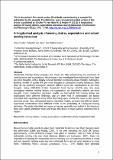Files in this item
A longitudinal analysis of moving desires, expectations and actual moving behaviour
Item metadata
| dc.contributor.author | Coulter, Rory Christopher | |
| dc.contributor.author | Van Ham, Maarten | |
| dc.contributor.author | Feijten, Peteke | |
| dc.date.accessioned | 2015-04-24T09:31:02Z | |
| dc.date.available | 2015-04-24T09:31:02Z | |
| dc.date.issued | 2011-11 | |
| dc.identifier | 28221157 | |
| dc.identifier | 248a9b21-1670-4ef3-adc3-e17bd54c5893 | |
| dc.identifier | 000298975700014 | |
| dc.identifier | 82755196261 | |
| dc.identifier.citation | Coulter , R C , Van Ham , M & Feijten , P 2011 , ' A longitudinal analysis of moving desires, expectations and actual moving behaviour ' , Environment and Planning A , vol. 43 , no. 11 , pp. 2742-2760 . https://doi.org/10.1068/a44105 | en |
| dc.identifier.issn | 0308-518X | |
| dc.identifier.other | ORCID: /0000-0002-2106-0702/work/64697525 | |
| dc.identifier.uri | https://hdl.handle.net/10023/6569 | |
| dc.description.abstract | Residential mobility theory proposes that moves are often preceded by the expression of moving desires and expectations. Much research has investigated how individuals form these premove thoughts, with a largely separate literature examining actual mobility. Although a growing number of studies link premove thoughts to subsequent moving behaviour, these often do not distinguish explicitly between different types and combinations of premove thoughts. Using 1998-2006 British Household Panel Survey data, this study investigates whether moving desires and expectations are empirically distinct premove thoughts. Using multinomial regression models we demonstrate that moving desires and expectations have different meanings, and are often held in combination: the factors associated with expecting to move differ depending upon whether the move is also desired (and vice versa). Next, using panel logistic regression models, we show that different desire expectation combinations have different effects on the probability of subsequent moving behaviour. The study identified two important groups generally overlooked in the literature: those who expect undesired moves and those who desire to move without expecting this to happen. | |
| dc.format.extent | 19 | |
| dc.format.extent | 365363 | |
| dc.language.iso | eng | |
| dc.relation.ispartof | Environment and Planning A | en |
| dc.subject | GF Human ecology. Anthropogeography | en |
| dc.subject.lcc | GF | en |
| dc.title | A longitudinal analysis of moving desires, expectations and actual moving behaviour | en |
| dc.type | Journal article | en |
| dc.contributor.institution | University of St Andrews. Geography & Sustainable Development | en |
| dc.contributor.institution | University of St Andrews. School of Geography and Geosciences | en |
| dc.identifier.doi | https://doi.org/10.1068/a44105 | |
| dc.description.status | Peer reviewed | en |
This item appears in the following Collection(s)
Items in the St Andrews Research Repository are protected by copyright, with all rights reserved, unless otherwise indicated.

